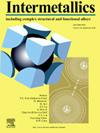Unveiling the influence of grain refinement and crystallographic orientation on electrochemical behavior of cost-effective Fe40Ni25Cr25Mo5Al5 high-entropy alloy
IF 4.3
2区 材料科学
Q2 CHEMISTRY, PHYSICAL
引用次数: 0
Abstract
This research has undoubtedly offered valuable insight into the correlation of grain refinement and crystallographic texture with the electrochemical properties of the cost-effective Fe40Ni25Cr25Mo5Al5 high-entropy alloy in a 0.5 M H2SO4 solution, successfully processed through the cyclic closed-die forging (CCDF) technique for up to six passes. The findings revealed that the high strains imposed during CCDF processing, along with the uniform distribution of extremely fine grains, significantly decreased the corrosion current density of the alloy from 1.05 to 0.75 μA/cm2. Moreover, the presence of high-intensity {011} orientations, such as the Brass {011}<211> and P {110}<221> components in the CCDF-processed alloy, provided ideal conditions for developing oxide passive films with superior protection properties compared to the as-homogenized alloy. Consequently, these findings open new avenues for the exploration of the crystallographic-orientation-dependent electrochemical properties in the corrosion performance of high-entropy alloys.

揭示了晶粒细化和结晶取向对高性价比Fe40Ni25Cr25Mo5Al5高熵合金电化学行为的影响
本研究无疑为具有成本效益的Fe40Ni25Cr25Mo5Al5高熵合金在0.5 M H2SO4溶液中晶粒细化和晶体织构与电化学性能之间的关系提供了有价值的见解,并成功地通过循环闭式模锻(CCDF)技术进行了多达六道次的加工。结果表明,在CCDF加工过程中施加的高应变和极细晶粒的均匀分布使合金的腐蚀电流密度从1.05 μA/cm2显著降低到0.75 μA/cm2。此外,高强度{011}取向的存在,如黄铜{011}<;211>;P {110}<221>;在ccdf加工的合金中,为开发具有优越保护性能的氧化钝化膜提供了理想的条件。因此,这些发现为探索高熵合金腐蚀性能中晶体取向相关的电化学特性开辟了新的途径。
本文章由计算机程序翻译,如有差异,请以英文原文为准。
求助全文
约1分钟内获得全文
求助全文
来源期刊

Intermetallics
工程技术-材料科学:综合
CiteScore
7.80
自引率
9.10%
发文量
291
审稿时长
37 days
期刊介绍:
This journal is a platform for publishing innovative research and overviews for advancing our understanding of the structure, property, and functionality of complex metallic alloys, including intermetallics, metallic glasses, and high entropy alloys.
The journal reports the science and engineering of metallic materials in the following aspects:
Theories and experiments which address the relationship between property and structure in all length scales.
Physical modeling and numerical simulations which provide a comprehensive understanding of experimental observations.
Stimulated methodologies to characterize the structure and chemistry of materials that correlate the properties.
Technological applications resulting from the understanding of property-structure relationship in materials.
Novel and cutting-edge results warranting rapid communication.
The journal also publishes special issues on selected topics and overviews by invitation only.
 求助内容:
求助内容: 应助结果提醒方式:
应助结果提醒方式:


